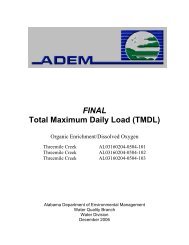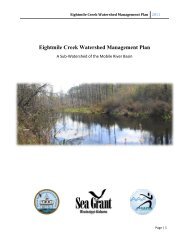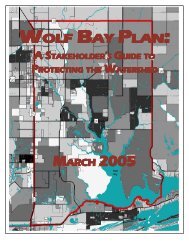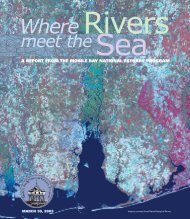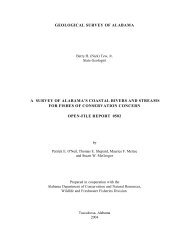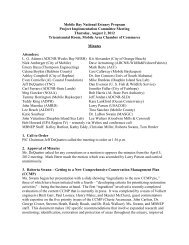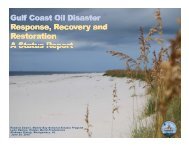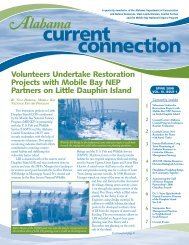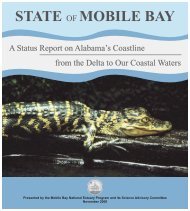Conserving Alabama's Coastal Habitats - Mobile Bay National ...
Conserving Alabama's Coastal Habitats - Mobile Bay National ...
Conserving Alabama's Coastal Habitats - Mobile Bay National ...
- No tags were found...
You also want an ePaper? Increase the reach of your titles
YUMPU automatically turns print PDFs into web optimized ePapers that Google loves.
These open pine woodlands occupy sandy flatlands principally in the Gulf Coast flatwoods of the southeasternplains. Pine flatwoods also may be found in portions of the Southern Pine Plains and Hills and the DoughertyPlain subdivisions, where they may be a component of a landscape matrix of several other habitats including xericpine and floodplain forest. Even though this habitat is subject to seasonally high water tables, fire frequency ishigh. Over story vegetation is characterized by longleaf pine and to a lesser degree by slash pine. The understoryranges from dense shrubs to open and herbaceous-dominated, and is heavily influenced by fire history. Thishabitat shares many wildlife species with dry longleaf pine forest, but the flatwoods salamander is found onlyin this habitat. Representative high-quality sites include Grand <strong>Bay</strong> (<strong>Mobile</strong> County), Splinter Hill Bog (BaldwinCounty) and Conecuh <strong>National</strong> Forest (Escambia and Covington counties).(Source: http://www.outdooralabama.com/research-mgmt/cwcs/Chapter4.pdf)Habitat OpportunitiesThere are many opportunities to conserve and restore habitat in the Grand <strong>Bay</strong> area. These opportunities include:sea grass restoration, habitat improvement, fire restoration, control of invasive/exotic species, hydrologic restoration,creation of wood duck nesting boxes, shoreline restoration, and opportunity to mitigate the effects of county dirtroad maintenance.Habitat ThreatsThe biological diversity and complex of natural community assemblages represented at Grand <strong>Bay</strong> are amongthe Nation’s finest, although the future of these resources is not secure. Not unlike many of North America’s finestnatural areas, Grand <strong>Bay</strong> is besieged by a variety of environmental stresses, many related to the continuedpopulation growth in coastal Alabama and Mississippi. While outright habitat destruction is usually quiteobvious, alteration and degradation of sensitive habitats can be more subtle. Often occurring over long periods oftime, habitat degradation lacks the dramatic impact of outright habitat destruction. While habitat destruction is akey threat to Grand <strong>Bay</strong>, impacts from habitat degradation seem to be currently more impending. Degradationsoccurring due to habitat fragmentation caused by roads and utility corridors, the results of population growth;changes in water quality; spread of non-native species and the elimination of key natural ecological processes.The majority of upland habitats at Grand <strong>Bay</strong> have been converted to agriculture, forestry or residential. Thebiodiversity at Grand <strong>Bay</strong> is generally concentrated in wetland communities.Primary Ecological FunctionThe biological significance of Grand <strong>Bay</strong> lies in the mosaic natural community occurrences and the ecologicalprocesses that maintain them, specifically through fire. At least 20 natural community types and 31 rare andimperiled species are found at Grand <strong>Bay</strong>, including 21 plant species, 4 crayfish species, and 4 turtle species.The wet pine savanna ecosystems of the southeastern United States are among the most diverse of all terrestrialcommunities found in North America. More plant species per square meter occur in some savanna types than inany other habitat.13



